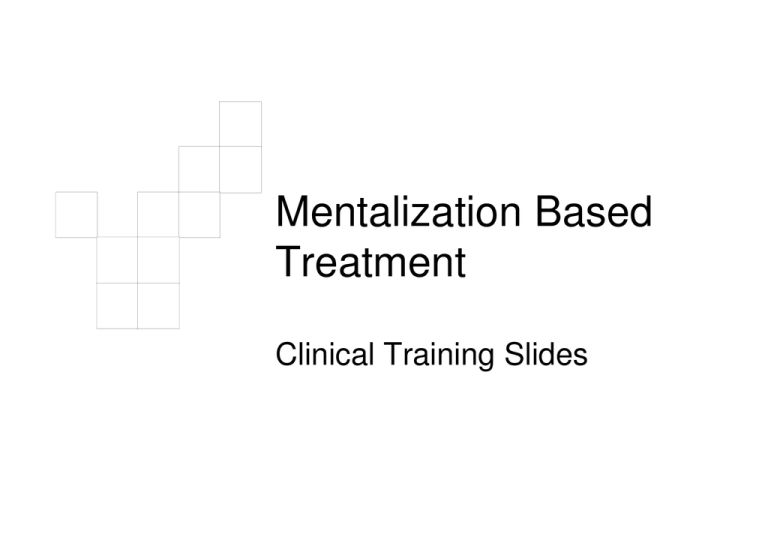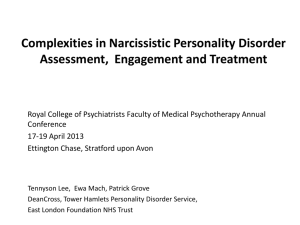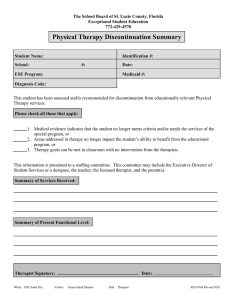Mentalization Based Treatment Clinical Training Slides
advertisement

Mentalization Based Treatment Clinical Training Slides Role Plays Clinician Interview as you normally do Don’t try to do anything original! Try to explain to the patient what you are trying to do at some point Observers to help you out whilst monitoring what is a mentalizing intervention and what is not. Patient Be a moderate and not the extreme person with BPD Respond as you think your patient would Monitor how the clinician makes you feel – misunderstood, secure, s/he is interested, makes you think etc What was it that made you feel like that or altered your mind state? Structure of Mentalization Based Treatment Assessment MBT-I MBT Trajectory of Treatment Assessment and assessment of mentalizing Giving Diagnosis Formulation Crisis Plan and risk assessment Contracting including barriers to treatment Outcome monitoring MBT-I MBT Goals of initial phase Engagement in treatment Motivation Stabilise factors undermining treatment Target high risk behaviours Identify long term goals – relationships and constructive activity Finalise formulation Establishing a Diagnosis How would you describe yourself as a person? What makes you an individual? How would someone else describe you? What sort of person are you in close relationships? What are your best features as a person? Crisis Plans Integrate with normal crisis planning system 3 major components Information for patient – what can he do? Information for health care professionals –what can they do? Information for others including what not to do Information for me: Positive things I can do when I am in a crisis: Things which have not been helpful when I have been faced with crises in the past: Staying up all night; admitted to hospital; increasing the dosage of my medication as this prolongs my stay in hospital; health professionals concentrating on my past history instead of current problems Information for healthcare professionals: My difficulties as I see them now: I am addicted to cannabis, I often go out of my way to get it (which puts me in danger); I have several worries about family and thinking about them can make me feel very depressed; attempting to deal with the problems in my life can lead to thoughts of suicide Details of any current treatment / support from health professionals: Physical illnesses & medication: Specific refusals regarding treatment during a crisis: I do not want to be hospitalised unless it is absolutely necessary; please don’t make decisions about my treatment without including me in the discussion first Things I would like professionals to do which may help me when I am in a crisis: Situations which can lead to a crisis: Things which professionals have said or done which have not been helpful in the past: Practical Help in a Crisis: Agencies or people that I would like to have copies of this Joint Crisis Plan: √ Myself √ My GP, Dr. X √ My Community Drug Project worker √ My CPN √ My partner Aims of Formulation Aims Organise thinking for therapist and patient – each sees different minds Modelling a mentalising approach in formal way – do not assume that patient can do this (explicit, concrete, clear and exampled) Modelling humility about nature of truth Management of risk Analysis of components of risk in intentional terms Avoid over-stimulation through formulation Beliefs about the self Relationship of these to specific (varying) internal states Historical aspects placed into context Central current concerns in relational terms Identification of attachment patterns – what is activated Challenges that are entailed Positive aspects When mentalisation worked and had effect of improving situation Anticipation for the unfolding of treatment Impact of individual and group therapy Formulation: Executive Summary Attachment Strategies and Interpersonal Problems Vulnerabililty factors from past experience Current use of alcohol and drugs Dependent, anxious with others, avoidant and devaluing Defers to others and vulnerable to exploitation Impulsivity and emotional problems Self-destructive behaviour, high risk of self harm Anxiety Mentalizing process Concrete, anti-reflective, sensitive Mentalizing Team United mind with a commonality of purpose Respect for themselves and others Ability to develop and adhere to coherent clinical plans Good team morale Effective leadership Structure of Team Meeting Identifying and marking the task Stating the focus for discussion Discussing the teams perspectives on the focus Returning to task to link the discussion with the focus Defining practical and clinical action Goals of Final Phase Increase patient responsibility and independent functioning Facilitate patient negotiation about future eg with outside organisations Consolidate and enhance social stability Collaboratively develop a follow-up treatment plan Enhance patient understanding of meaning of ending treatment Focus on affective states associated with loss Goals in Follow-up Phase Maintain gains in mentalizing that have been made Stimulate further rehabilitative changes Support for return to education or employment Negotiation of further interpersonal and social problems Large Group Exercise A patient calls you to say that he has had enough. He feels that no one cares about him. He doesn’t know what to do. Talk to him on the phone Observers to note mentalizing and nonmentalizing statements of therapist Large group exercise A patient in emotional crisis telephones you to say that she feels useless and nothing can be done. Even her boyfriend doesn’t answer the phone and she feels something awful is going to happen. Talk to her on the phone for a few minutes Observers to note mentalizing and nonmentalizing statements of therapist Summary and orientation to MBT Some General Principles - MBT Primary aim is to increase capacity to mentalize self and others Maintain or Regain mentalizing of clinician Monitor patient mentalizing capacity Manage arousal levels Focus on patient’s mind Address current events and immediate states of mind Step-wise intervention process starting with empathic validation Core Summary for new clinicians (1) 1. Collaborative process 2. Formulation of patient problems early in treatment and a focus in each session Trajectory of overall treatment and in each session 3. Identification of non-mentalizing process 4. General Attitude Not-knowing stance Principles for clinician Aim to re-store or maintain mentalizing Interventions consistent with the patient’s mentalizing capacity Identification of mentalizing poles Core Summary for new clinicians (2) 6. Principles for clinician (cont’d) Focus on maintaining clinician mentalizing Authentic and open-minded clinician Alert to breaks in mentalizing Monitoring of the state of affective arousal Focus on contingency and marking of interventions 7. Trajectory of sessions : interventions structured from empathic validation to exploration, clarification, and challenge through affect identification and affect focus to mentalizing the relationship itself 8. Explicit identification of clinician feelings related to the patient’s mental processing Linking theory with practice Problem Therapist Trust Alliance. Avoid overcompensating Social Scripts Follow social script Taking on others state of mind/Pretend Explore/Challenge/differentiate Contingent Empathic validation Self/other Marking Hyperactive attachment Therapist stance Theory to Practice: Contrary Moves Patient/Therapist Therapist/Patient External focus Internal focus Self- reflection Other reflection Emotional distance Emotional closeness Cognitive Affective Explicit Implicit Certainty Doubt Basic Mentalizing: Process Mentalizing Process - trajectory Narrative of event Experience at time Reflection on events Alternative perspective Experience talking about it in therapy Current feeling about events Mentalizing process Not directly concerned with content/narrative but with helping the patient Generate multiple perspectives to free himself up from being stuck in the “reality” of one view (primary representations and psychic equivalence) to experience an array of mental states (secondary representations) and to recognize them as such (meta-representation) Interventions: Basic Mentalizing ‘Stop, Listen, Look’ During a typical non-mentalizing story o stop and investigate o Let the interaction slowly unfold – control it/microslice o highlight who feels what o Identify how each aspect is understood from multiple perspectives o Challenge reactive “fillers” o Identify how messages feel and are understood, what reactions occur When patient able to mentalize to some degree What do you think it feels like for X? Can you explain why he did that? Can you think of other ways you might be able to help her really understand what you feel like? How do you explain her distress/overdose If someone else was in that position what would you tell them to do Interventions: Basic Mentalizing Stop, Re-wind, Explore Lets go back and see what happened just then. At first you/I seemed to understand what was going on but then… Lets try to trace exactly how that came about Hang-on, before we move off lets just re-wind and see if we can understand something in all this. Labeling with qualification (beware) (“I wonder if…” statements) Explore manifest feeling but identify consequential experience – You say you are anxious with others so I wonder if that leaves you feeling a bit left out? ‘I wonder if you are not sure if it’s OK to show your feelings to other people?’ Maintaining Motivation Demonstrate support, reassurance and empathy as you explore the patients mind Model reflectivity Identify the discrepancy between the experience of the self and the ideal self – ‘how you are compared with how you would like to be’ ‘Go with the flow’ or ‘roll with the resistance’ Re-appraise gains and identify areas of continuing problem Highlight competencies in mentalizing and listen for mentalizing strengths Summary Process ‘Stop, Listen, Look’ Stop, Re-wind, Explore Stop and Stand Affect and Interpersonal regulation in session Intervention Empathy Clarification Exploration Challenge Affect identification Affect Focus Interpersonal Therapist stance Therapist/Patient Problem THERAPY STIMULATES ATTACHMENT SYSTEM EXPLORATION DISCONTINUITY OF SELF ATTEMPT TO STRUCTURE by EFFORT TO CONTROL SELF &/OR OTHER Therapist/Patient Problem ATTEMPT TO STRUCTURE by EFFORT TO CONTROL SELF &/OR OTHER RIGID SCHEMATIC REPRESENTATION NON-MENTALIZING CONCRETE MENTALIZING (PSYCHIC EQUIVALENCE) PSEUDO MENTALIZING (PRETEND) MISUSE OF MENTALIZING Therapist Stance Not-Knowing Neither therapist nor patient experiences interactions other than impressionistically Identify difference – ‘I can see how you get to that but when I think about it it occurs to me that he may have been pre-occupied with something rather than ignoring you’. Acceptance of different perspectives Active questioning Eschew your need to understand – do not feel under obligation to understand the non-understandable. Monitor you own misunderstandings Model honesty and courage to accept mentalizing errors via acknowledgement of your own misunderstanding o Current o Future Suggest that misunderstandings offer opportunities to re-visit to learn more about contexts, experiences, and feelings Highlighting alternative perspectives I saw it as a way to control yourself rather than to attack me (patient explanation), can you think about that for a moment You seem to think that I am not listening and yet I am not sure what makes you think that (or validate if correct!) Help me see it like that. I am not aware that you did not do well. It seems that it was a success to me. Therapist stance Empathic is about how they are thinking and feeling, getting them to describe important experience Cannot explore before empathy established Use not knowing what to say as clue that something does not make sense and there is something to be curious about Curiosity about experience, probing about patients experience serves to validate the experience Normalizing is component of moving to detailed work – stating feelings in first person: “I would feel X if I was in that situation too…” Essential to the Stance Keep it current – what the patient feels right now Start by empathising – finding a way of stating that you genuinely understand distress –GO ALONGSIDE THE PATIENT See the experience through their eyes and mind Explore in the relational realm not just the intrapsychic Lower arousal by bringing it to the person of the therapist What have I done? Stick to mentalizing aim in somewhat dogged manner Quickly step back if patient seems to lose control Therapist Stance Explicit Mentalization Not directly concerned with content Obtain narrative to focus session Beware persistent focus on narrative description Exploration draws attention back to implicit representations—feelings for example use language to bolster engagement on the implicit level of mentalization highlight the experience of “feeling felt” (mentalized affectivity) Therapist Stance Using questioning comments to promote exploration What do you make of what has happened? Describe your experience to me in more detail. Where in your body did you first feel that? I wonder (beware of wondering too often!) if that was related to the group yesterday? Perhaps you felt that I was judging you? Why do you think that he said that?* What do you make of her suicidal feeling (in the group)?* Why do you think that he behaved towards you as he did?* *ONLY IF PATIENT NOT IN PSYCHIC EQUIVALENCE Workshop Exercise Patient to talk about incidents in his/her life Therapist Inquisitive stance – not knowing/humility Rebalance the mentalizing problem – self to other or other to self Empathic Validation Explore the incident with curiosity Control the process Focus on the incident Labelling of Affect Therapist to focus patient attention on current situation Workshop Exercise Patient reports that he has got into an argument at work and suspended pending an inquiry. Therapist Inquisitive stance Therapist to focus patient attention on current situation Explore the incident Elaborate mental states of protagonists Stimulate alternative perspectives Demonstrate humility - not knowing Monitor for non-mentalizing and try to Intervene to move patient to mentalizing Video Therapist Stance The mentalizing focus Clinical Process - summary Narrative to alternative perspective Intervention spectrum from ‘surface to depth’ Intervention choice determined by arousal level External events to current treatment process to patient-clinician interaction Clinical summary of momentary session intervention Identify a break in mentalizing – psychic equivalence, pretend, teleological Rewind to moment before the break in subjective continuity Intervention according to mentalizing problem Explore current emotional context in session by identifying the momentary affective state between patient and therapist Identify your contribution to the break in mentalizing Seek to mentalize the relationship if mentalizing remains robust Modes of non-mentalizing PSYCHIC EQUIVALENCE Clinical form Certainty/suspension of doubt Absolute Reality defined by self-experience Finality – It just is. Internal = external Therapist experience Puzzled Wish to refute Statement appears logical but obviously over-generalised Not sure what to say Angry or fed up and hopeless Intervention Empathic Validation with subjective experience Curious – how did you reach that conclusion Presentation of clinician puzzlement (marked) Linked topic (diversion) to trigger mentalizing then return to psychic equivalent area Iatrogenic Argue with patient Excessive focus on content Cognitive challenge Modes of non-mentalizing PRETEND MODE Clinical form Inconsequential talk/groundless inferences on mental states Lack of affect. Absence of pleasure Circularity without conclusion – spinning in sand (hypermentalizing) No change Dissociation – self harm to avoid meaninglessness Body-Mind decoupled Therapist experience Boredom Detachment Patient agrees with your concepts and ideas Identification with your model Feels progress is made in therapy Intervention Probe extent. Counter-intuitive Challenge Iatrogenic Non-recognition Joining it with acceptance as real Insight orientated/skill acquisition intervention Modes of non-mentalizing TELEOLOGICAL MODE Clinical form Expectation of things being ‘done’ Outcomes in physical world determine understanding of inner state – ‘I took an overdose; I must have been suicidal. Motives of others based on what actually happens Only actions can change mental process ‘What you do and not what you say’ Therapist experience Uncertainty and anxiety Wish to do something – medication review, letter, phone call, extend session. Intervention Empathic validation of need Do or don’t do according to exploration of need Affect focus of dilemma of doing Iatrogenic Excessive ‘doing’ Prove you care in belief it will induce postive change Elasticity (extending what you do e.g. extra sessions, only to rebound with extra constraints) rather than flexibility General Characteristics of Interventions In keeping with patient mentalizing capacity Affect focused (love, desire, hurt, catastrophe, excitement) Explicitly interpersonal and affective Relate to current event or activity – mental reality (evidence based or in working memory) De-emphasise unconscious concerns in favour of near-conscious or conscious content Spectrum of Interventions Empathic validation – including reassurance, support & empathy Basic Mentalizing - Clarification, Exploration and Challenge Basic Mentalizing – Affect identification and Affect focus Mentalizing the relationship Interventions: Spectrum Safe in low Anxiety Safe in high Anxiety Supportive/empathic Clarification, elaboration, challenge Basic mentalizing – affect and affect focus Mentalizing the relationship Interventions: Supportive & empathic Provoke curiosity about motivations Highlight own interest in mental states Qualify own understanding and inferences – ‘I can’t be sure but’; ‘may be you’; ‘I guess that you’ Guide others’ focus towards experience and away from “factual fillers” Demonstrate how subjective information could help to make sense of things Proscribed statements What you really feel is… I think what you are really telling me is ….. It strikes me that what you are really saying… I think your expectations of this situation are distorted What you mean is… Empathic Validation – Affect and Effect Interest in and Reflection on Affect Identification of feelings Normalising when possible in context of present and past Seeing it through their eyes What effect does this experience have on them Interventions: Supportive & empathic Respectful of their narrative and expression Positive/hopeful but questioning Unknowing stance – you cannot know their position Demonstrate a desire to know and to understand Constantly check-back your understanding – ‘as I have understood what you have been saying is… Spell out emotional impact of narrative based on common sense psychology and personal experience For the patient but not acting for them – retains patient responsibility Interventions: Supportive & empathic Identifying and exploring positive mentalizing judicious praise – ‘you have really managed to understand what went on between you. Did it make a difference’. Examine how it feels to others when such mentalizing occurs – ‘how do you think they felt about it when you explained it to them Explore how it feels to self when an emotional situation is mentalized – ‘how did working that out make you feel’ Identifying non-mentalizing fillers Fillers: typical non-mentalizing thinking or speaking, trite explanations Highlight these and explore lack of practical success associated with them Clarification and Affect Focus Intervention: Clarification & Affect elaboration Clarification is the ‘tidying up’ of behaviour which has resulted from a failure of mentalization Establish important ‘facts’ from patient perspective Re-construct the events Make behaviour explicit– extensive detail of actions Avoid mentalizing the behaviours at this point – only begin promoting mentalizing once facts available Trace action to feeling Seek indicators of lack of reading of minds Affect elaboration Normalise when possible – ‘given your experience it is not surprising that you feel X’ Identify, name and give context to emotion - labelling Explore absence of motivating emotions – relentless negativity is wearing to others Identify mixed emotional states Intervention: Clarification & Affect elaboration Labelling feelings During non-mentalizing interaction therapist firmly tries to elicit feelings states Therapist recognises mixed emotions– probe for other feelings than first, particularly if first emotion is unlikely to provoke sympathy in others or lead to rejection (e.g. frustration, or anger) c.f. basic and social emotions Reflect on what it must be like to feel like that in that situation –’ if that was me I would feel X’ Try to learn from individual what would need to happen to allow them to feel differently How would you need others to think about you, to feel differently? Affect Focus: Making implicit mentalizing explicit Not the affect associated with the story or event Patient may have different affect related to story Affect focus is current affect as experienced in the telling of the story Make explicit if important in interpersonal terms in patient/clinician relationship Naturally moves towards mentalizing the relationship Current affective interpersonal experience = affect focus Define the current affective state shared between patient and therapist Do this tentatively from your own perspective Do not attribute it to the patient’s experience Link the current affective state to therapeutic work within the session itself Exploration Process of Exploration During a typical non-mentalizing interaction in a group or individual session Stop and investigate Let the interaction slowly unfold – control it Highlight who feels what Identify how each aspect is understood from multiple perspectives Challenge reactive “fillers” Identify how messages feel and are understood, what reactions occur Process of Exploration If patient not in psychic equivalence: What do you think it feels like for X Can you explain why he did that? Can you think of other ways you might be able to help her really understand what you feel like? How do you explain her distress/overdose If someone else was in that position what would you tell them to do Process of Rewind and Exploration Draw attention to disjunction in topic/dialogue/ tone Let’s go back to see what happened just then. At first you seemed to understand what was going on but then… Lets try to trace exactly how that came about Hang on, before we move off, let’s just rewind and see if we can understand something in all this. Oh I thought we were talking about your child and now you are suddenly on the gearbox in your car? What happened there to make such a jump? Challenge or Stop and Stand Challenge - aims Bring non-mentalizing to an abrupt halt even if only momentarily Surprise the patient’s mind; trip their mind back to a more reflective process Grasp the moment – stop and stand - if they seem to respond Steady Resolve Challenge - indicators Persistent non-mentalizing especially in high risk contexts Pretend Mode Fixed position in one or more dimensions of mentalizing Inadequate progress in treatment Challenge - characteristics Infused with compassion Non-judgemental Unheralded, left-field, surprise Outside the normal therapy dialogue but within the frame of professional treatment Targets affect using empathic validation more often than cognition Use humour when possible Challenge - strategies Counter-intuitive statements Mischievous or Whacky comments Therapist emotional expression to rebalance patient emotional expression Frank but Fair Challenge in boundary violation Clarify your boundary (should be a repetition of boundary agreed when treatment began) When all avenues explored state impasse – ‘As far as I can tell we are going round in circles. When I say something you simply dismiss it as rubbish and whilst I am willing to accept that it sometime is, I cannot accept that it always is. State own position – ‘If we can’t get around this I may have to say that treatment has failed and we should finish Monitor feelings in clinician to ensure no impulsive action by therapist Workshop Exercises Workshop Exercise Patient does not feel that you understand and think that it would be better to have another therapist. Therapist Empathic position Clarification Elaboration and affect focus Stop and stand if necessary Rewind and explore Work within the current relationship if the patient allows it and if not see if you can create circumstances so the patient can focus and consider the relationship. Workshop Exercise Patient has been shouting at staff and/or complains about another member of staff.. Therapist has to address what has been happening. Therapist Empathic validation Clarification Elaboration and affect focus Rewind and Explore Stop and stand if necessary (Work within the relationship if the patient allows it and if not see if you can create circumstances so the patient can focus and consider the relationship.) Workshop Exercise to use Basic Mentalizing and mentalizing the relationship Patient – Discuss an important relationship and allow the story to unfold when prompted Therapists: Basic mentalizing Stop, Look, and Listen and explore important content Stop, rewind, and explore Stop and stand if patient uses non-mentalizing Therapist: transference tracers and mentalizing the relationship Workshop Exercise Therapist feels that the therapy is stuck and cannot see that it is likely to go anywhere and feels that ending therapy should be considered. Patient has not indicated that she feels similarly Raise the subject with the patient and explore. Guidance on which intervention when Interventions: Spectrum Least involved Most involved Supportive/empathic Clarification, elaboration, challenge Basic mentalizing, Affect Focus Mentalizing the relationship Which intervention to use when? If in doubt start at the surface empathic validation Move to ‘deeper’ levels only after you have performed earlier steps If emotions are in danger of becoming overwhelming take a step towards the surface Type of intervention is inversely related to emotional intensity – empathic validation being given when the patient is overwhelmed with emotion; mentalizing relationship when the patient can continue mentalizing whilst ‘holding’ the emotion. Intervention must be in keeping with patients mentalizing capacity. Danger is assuming that people with BPD have a greater capacity than they actually have when they are struggling with feelings. Self-harm Function To re-establish the self-structure following loss of mentalizing Intervention Explore reasons for destabilisation of selfstructure ‘Tell me when you first began to feel anxious that you might do something?’ Mentalizing functional analysis Understanding suicide and self-harm in terms of the temporary loss of mentalization Loss Increase attachment needs triggering of attachment system Failure of mentalization Psychic equivalence intensification of unbearable experience Pretend mode hypermentalization meaninglessness, dissociation Teleological solutions to crisis of agentive self suicide attempts, self-cutting Step-wise Intervention Contingent response = empathic validation with current state Establish joint reflection on suicide/selfharm/violence Affect focus if no joint reflection – presentation of shared dilemma Identify moment of ‘loss’, attachment trigger and context Work towards recognition/awareness of vulnerability points and context representation Intervention algorithm SelfHarm/Suicide Collaborative agreement to explore No agreement to explore Explore difficulty of talking about events Affect focus the shared problem Elephant in Room Psychic Equivalence Restore mentalizing Counterrelationship presentation Mentalizing functional analysis Rewind to point of mentalizing Mentalizing Functional Analysis Seek point of vulnerability Stop and Rewind to point before mentalizing was lost Stop and Explore a point when mentalizing was taking place Micro-slice mental states towards the self destructive act Continually move around self and other mental states Place responsibility for keeping mind on-line back with the patient Ask patient to identify when she could have possibly re-established self-control Mentalizing Functional Analysis Empathy validation and support collaborative stance You must not have known what to do? Define interpersonal context Detailed account of days or hours leading up to selfharm with emphasis on mental/feeling states Moment to moment exploration of actual episode Explore communication problems Identify misunderstandings or over-sensitivity Identify affect Explore the affective changes since the previous individual session linking them with events within treatment Review any acts thoroughly in a number of contexts including individual and group therapy – how could treatment focus better to prevent this action again? What can we do better? Mentalizing Functional Analysis Explore conscious motive How do you understand what happened? Who was there at the time or who were you thinking about? What did you make of what they said? Challenge the perspective that the patient provides if therapeutic alliance is robust DO NOT mentalize the relationship in the immediacy of a suicide attempt or self-harm Interpret the patient’s actions in terms of their personal history, the putative unconscious motivations or their current possible manipulative intent in the ‘heat’ of the moment. It will alienate the patient. Clinical Intervention: Self Harm and the Alien Self Theory: Birth of the Agentive Self Attachment figure “discovers” infant’s mind (subjectivity) Internalization Representation of infant’s mental state Core of psychological self Attachment figure Inference Infant Infant internalizes caregiver’ ’s representation to form psychological self Safe, playful interaction with the caregiver leads to the integration of primitive modes of experiencing internal reality mentalization Theory: Birth of the “Alien” Self in Disorganized Attachment The caregiver’s perception is inaccurate or unmarked or both Attachment Child Mirroring fails The nascent self Figure Absence of a representation of the infant’s mental state representational structure The Alien Self Internalisation of a non-contingent mental state as part of the self The child, unable to “find” ” himself as an intentional being, internalizes a representation of the other into the self with distorted agentive characteristics Theory: Self-destructiveness and Externalisation Following Trauma Torturing alien self Perceived other Self representation Unbearably painful emotional states: Self experienced as evil/hateful Self-harm state Attack from within is turned against body and/or mind. Theory: Self-destructiveness and Externalisation Following Trauma Torturing alien self Perceived other Self representation Unbearably painful emotional states: Self experienced as evil/hateful Self-harm state Torturing alien self Externalization Container Self Selfexperienced experienced asas hated evil and and attacked hateful Addictive bond Victimized state Projective identification is used to reduce the experience of unbearably painful emotional state of attack from within – externalisation becomes a matter of life and death and addictive bond and terror of loss of (abusing) object develops If someone was causing you pain or simply tormenting you, perhaps not everyday for the whole day, parts of a day, or for days and weeks on end, You could if you were brave or desperate enough, defend yourself, by perhaps attacking (and eliminating) your persecutor. But what if this thing you hate, was inhabiting your head? You can’t exactly say please leave my body, you can’t do anything to get it to just pack up and leave because technically, physically that isn’t possible. You can say fuck you. I hate you. You can self-harm with the hugest force your body can withstand, with all you can muster. You can do that. You can be very very angry and show them who’s boss, you won’t stand for it, you won’t take it lying down. You want to be heard, you want to say right, you think you can hurt me? I’ll show you, I’ll show you how much I can hurt you! But you and this thing, you are inhabiting one body. You attack this thing you attack yourself. You don’t have a choice though. That’s a sacrifice you make over and over. Eventually, you realise the only way to get rid of this thing, once and for all is getting rid of yourself. What choice do you really have? No doctor can specify the problem. No medication can fix the problem that can’t be specified. You fail to understand yourself. You can’t explain to your family and docs, they can’t help you because you do not talk. You doubt yourself “do I even have a problem?” People in real life often treat you like you don’t have a real problem. They talk to you stupidly, you complain that they don’t understand, you look a fool. Perhaps that is why you don’t talk to them anymore. Maybe you don’t have a problem anyway. You are a child, quite possibly you are just making this up for some attention, finding an excuse for why you can’t stay in college or get a job. Maybe you don’t have an excuse, you are just a stubborn little child. From what everyone tells you perhaps that is true. You have doubt. You are willing to listen to someone else. For now that is the only reason why you are not, at this moment trying to do it. Workshop exercise Patient describes having cut himself and requiring sutures. Therapist Identify feelings Develop context Integrate the relationship with you in the discussion Aim to re-instate a continuity of self-structure by kick starting mentalizing If unsuccessful work on what you and patient are to do perhaps by identifying an affect focus Transference and Countertransference Mentalizing the Relationship Interventions: Relational Mentalizing Reasons for working in the Transference/Relationship Poor long term outcome o Spontaneous improvements (recovery) o Relationship problems and life goals Attachment as the root to personality disorder o Nature of disorganized attachment o Avoidance as long term outcome Thinking about relationships: Internal working model o Self o Object o Affect Therapist Stance Reflective enactment Therapist’s occasional enactment is acceptable concomitant of therapeutic alliance Own up to enactment to rewind and explore Check-out understanding Joint responsibility to understand overdetermined enactments Interventions: Relational Mentalizing Transference tracers – always current Linking statements and generalization o ‘That seems to be the same as before and it may be that.. o ‘So often when something like this happens you begin to feel desperate and that they don’t like you’ Identifying patterns o It seems that whenever you feel hurt you hit out or shout at people and that gets you into trouble. May be we need to consider what happens. Making transference hints o I can see that it might happen here if you feel that something I say is hurtful Indicating relevance to therapy o That might interfere with us working together Interventions: Mentalizing the Relationship Working with the relationship (MUST be mentalizing) Emphasis on current Demonstrate alternative perspectives Contrast patient’s perception of the therapist to selfperception or perception of others in the group Link to selected aspects of the treatment situation (to which they may have been sensitised by past experience) or to therapist Highlight underlying motivation as evidenced in therapy Components of mentalizing the therapeutic relationship Validation of experience Exploration in the current relationship Accepting and exploring enactment (therapist contribution, therapist’s own distortions) Collaboration in arriving at an understanding Present an alternative/additional perspective Monitor the patient’s reaction Explore the patient’s reaction to the new understanding Therapist Affect (Mentalizing the Relationship) Focus the patient’s attention on therapist experience when it offers an opportunity to clarify misunderstandings and to develop prototypical representations Highlight patient’s experience of therapist Use alternative perspectives to emphasise different experience which needs exploring Negotiate negative reactions and ruptures in therapeutic alliance by identifying patient and therapist roles in the problem – accept your contribution Interventions: Mentalizing the relationship Dangers of using the relationship Avoid interpreting experience as repetition of the past or as a displacement. This simply makes the person with BPD feel that whatever is happening in therapy is unreal Thrown into a pretend mode Elaborates a fantasy of understanding with therapist Little experiential contact with reality No generalization Components of mentalizing the counter-relationship Monitor states of confusion and puzzlement Share the experience of not-knowing Eschew therapeutic omnipotence Attribute negative feelings to the therapy and current situation rather than the patient or therapist (initially) Aim at achieving an understanding the source of negativity or excessive concern etc. Components of mentalizing the counter-relationship Anticipation of response/reaction of patient Mark your statement Do not attribute what you experience to the patient Keep in mind your aim Re-instate your own mentalizing Identify important emotional interaction that affects therapy relationship Emphasise that minds influence minds Typical Counter-relationship emotions Pretend mode Boredom, temptation to say something trivial Sounding like being on autopilot, tempting to go along Lack of appropriate affect modulation (feeling flat, rigid, no contact,) Teleological Anxiety Wish to DO something (lists, coping strategies) Psychic equivalence Puzzlement, confused, unclear, excessive nodding Not sure what to say, just going Anger with the patient Workshop Exercise Patient states that they feel you are a bully because you keep making them talk about things they do not want to talk about. Therapist Affect focused clarification Elaboration in context of current relationship Work within the relationship Mentalize the relationship Workshop Exercise Patient tells a story about how she was angry and shouted at her 4 year old child. Then she states that she knows that you are appalled by her. Therapist Affect focused clarification Elaboration in context of current relationship Work within the relationship Mentalize the relationship Mentalizing and Group Psychotherapy Mentalizing and Groups MBT Group Two types of groups MBT- I MBT-I: Psychoeducation for BPD MBT-I An introduction to mentalising Introduction pathway A psycho-educational perspective runs through the entire treatment philosophy of MBT Joint formulation Crisis plans Family involvement Leaflets Importance of therapists mental state Adaptations Mental Health Centres Addiction clinics Inpatient units Mothers with BPD who have children Other Clinical Features of Borderline Personality Disorder (DSM-IV: 5 of 9) a pattern of unstable intense relationships, inappropriate, intense anger unstable relationships frantic efforts to avoid abandonment affective dysregulation affective instability, impulsive actions impulsivity recurrent self-harm & suicidality, chronic feelings of emptiness or boredom aggression (dysphoria), transient, stress-related paranoid thoughts identity disturbance severe dissociative symptoms MBT-I Structure 2 therapists Observer(s) 6-12 members 12 sessions of 1.5 hours Diagnoses definite or probable BPD Explicit Mentalizing Group Exercises are arranged in a sequence progressing from emotionally ‘distant’ scenarios to some which are more personalized. Are related to personal experience only when the group have developed a cohesive atmosphere and some trust has been established between participants. are developed to ensure that there is a focus on ‘self’ or ‘other’ and on the perceptions and experiences of others about self or self about others. Move between explicit and implicit mentaling Introductory part of 1st session Introductions Details of group times, duration, structure etc Rules of group (eg confidentiality, alcohol) Information sheet provided Topics Personality structure Emotions, cognitions, behaviours The interpersonal realm Structure of each session Feedback from previous session and task Activity to explore mentalising Information provided Task for the week 12 Structured Sessions Session 1 What is mentalizing and a mentalizing attitude Session 2 What does it mean to have problems with mentalizing Session 3 Why do we have emotions and what are the basic types Session 4 How do we register and regulate emotions? Mentalizing emotions Session 5 The significance of attachment relationships Session 6 Attachment and mentalization 12 Structured Sessions Session 7 What is personality disorder with focus on BPD Session 8 Mentalization Based Treatment Sessions 9 Mentalization Based Treatment Session 10 Anxiety, attachment and mentalizing Session 11 Depression, attachment and mentalizing Session 12 Summary and Conclusion MBT-I Session 1 What is mentalising? Discussion of what is in our mind What does it involve Being aware of thoughts and feelings Is it the same as empathy? Includes oneself as well as others Emotion disrupts mentalising Group activity What would you think if in your home town you saw a foreign-looking man standing at the corner of an intersection studying a map, looking up and down the various streets with a questioning expression on his face? Make some notes. Group activity discussion People interpret the same event in different ways Some interpretations are more plausible than others Some statements about the object is mentalizing (e.g. “I believe that he is confused”), while others are not (e.g. “he comes from a foreign country”) Emphasis is on distinction between mentalizing and non-mentalizing Danger signs – in life and in group Absolutes Words Just Clearly Everyone All Certainty Attributing motives to others Defensiveness Group activity Two patients are invited to role play The one will be interviewing the other. The task is to find out what is in the mind of another person in context of them mentioning a problem using a mentalising stance. ‘I could not sleep last night’. Final summary Session 1 Mentalising is important to: understand what is taking place between people. understand yourself, who you are, your preferences, your own values, etc. communicate well with your close friends. regulate your own feelings. regulate other people’s feelings. avoid misunderstandings. see the connection between emotions and actions more easily, so that you can escape destructive patterns of thoughts and feelings more easily Homework – not-knowing stance Practice using a mentalising stance Encouraged patients to find a friend or someone in their family to interview using a mentalizing stance, i.e. about how the other person was earlier in the day or yesterday. Patients are encouraged to ask questions in a curious, non-knowing and non-judgmental way Identify moods, thoughts and emotions Note how it makes them feel and also ask their interviewees how it makes them feel. MBT-I Session 2 Problems with mentalizing Session 2 Problems with mentalizing It is Sarah’s birthday. She is planning to celebrate with Mike, her boyfriend, and has invited him home for dinner. She has purchased wine to go with the food, and is looking forward to him coming after work. When Mike arrives, he does not have a gift with him, and he says to her “wow, what a dinner you have made, and on a Tuesday”. During dinner Sarah is quiet and drinks most of the wine herself. What happened? Why do you think Sarah behaves the way she does? Discussion and identification of non-mentalizing Feeling certain about other people’s motives Thinking in black-white terms (i.e. without nuances) Poor acknowledgement of accompanying feelings (reduced empathy) Overlooking the fact that people influence each other Interpretation of others without careful consideration may be irrelevant, be off the point, or even be very concrete (i.e. that first this happened then that happened, etc) Little curiosity about mental states Lots of words are spoken with limited content Speech is filled with clichés and fancy words that do not seem to have been digested and that tend to alienate the discussion partner External factors are emphasised at the expense of mental states, for example that it rained, or that one had a headache, or the situation is described as being “just how it was”, without any more explanation. MBT-I Session 3 Emotions What are the basic emotions? Fear Anger Sexual lust Interest and curiosity, exploratory behaviour Separation anxiety/sadness Love/caring Play/joy (Craving) What are socialised or secondary emotions? Reactions/responses to primary emotions Shame Guilt Envy Gratitude Jealousy Cheerfulness Astonishment MBT-I Session 5 Attachment and How do I know who I am? Theory: How do I know who I am? Attachment figure “discovers” infant’s mind (subjectivity) Internalization Representation of infant’s mental state Core of psychological self Attachment figure Inference Infant Infant internalizes caregiver’ ’s representation to form psychological self Safe, playful interaction with the caregiver leads to the integration of primitive modes of experiencing internal reality mentalization Attachment theory Separation anxiety Annihilation Paranoid anxiety Autonomous Dismissive/detached Protest Despair Detachment Pre-occupied Enmeshed Incoherent Bowlby’s Attachment Theory Need of human infant to seek protection and security through physical contact with the caregiver Attachment system Caregiving system Attachment behaviours Caregiving behaviours proximity seeking clinging smiling - touching - holding - soothing Affectional bond: expectation of being offered care Attachment Classification: Secure Parenting behaviour co-ordinated sensitive stabilised emotional response Developmental impact organised in stress negative emotions feel less frightening (meaningful, communicative) Attachment Classification: Anxiousavoidant Parenting behaviour emotional arousal not re-established over-aroused through intrusive parenting caregiver unresponsive or intolerant Developmental impact over-regulate affect avoid distressing situations seeking proximity is futile avoid disclosing dependence attachment behaviours are deactivated Attachment Classification: Anxiousresistant Parenting behaviour inconsistent responsiveness Developmental impact under-regulate, heightening expression of distress in order to elicit caregiving responses low threshold for threat preoccupied with contact with caregiver vigilant for presence or loss of caregiver proximity not soothing but results in persistent anxiety Attachment Classification: Disorganised Parenting behaviour attachment figure simultaneously source of reassurance and fear prolonged separation intense marital conflict neglect physical or sexual abuse Developmental impact capacity to respond to stress most compromised disorganisation disorientation dissociation bizarre repetitive movements self-harm, self-mutilation extreme controlling behaviour Group Activity Tom and his girlfriend, Sara, meet again after the university holidays. During the holidays, Tom has not called Sara and when she called or sent an SMS he did not answer. Sara did very little during her holidays, but when Tom asked her about it she answered: ”I had a fantastic holiday with plenty to do. I wish the holiday had lasted longer.” Discuss this episode in light of attachment strategies for Tom and Sara Why does Sara answer as she does? Group Activity Think about a relationship with an important person in your life (girlfriend, boyfriend, family member, friend) and whether it is secure, ambivalent or distanced Provide examples and think about how that pattern of relationship developed Examples of Tasks Be aware of changes in your mood and what might be causing them Monitor own attachment behaviour Monitor own reading of others’ behaviour Monitor others’ reactions to us Addictions: Session 2 What kind of mentalizing problems do you believe may predispose for excessive alcohol/drug consumption? What kind of mentalizing problems may arise as a consequence of excessive alcohol/drug consumption? Addictions: Session 3 Add ‘craving to basic emotions Describe your craving for states of intoxication. Is it one or many feelings? Where is it located? How can it be put into words? What kind of feelings have been most important for you to regulate with psychoactive substances? Addictions Session 6/7 Attachment and mentalizing If somebody in the family abused substances, make some notes on what kind of consequences you believe that would have for the culture or ways of relating in the family Make some notes on your own personality traits that might have been augmented by substance abuse Make some notes on how you believe your own behaviour when intoxicated may have affected other people MBT Group MBT - Group Problems resulting from failure to mentalize arise: Outside the group (in lives of patients) Within the group (between the patients in group sessions) Patients encouraged to consider both the above using a mentalizing framework Why a change in emphasis for severe PD? Poor research evidence behind the Foulkesian claim that groups with severe personality disorders can develop productive group culture by the help of a minimally engaged group therapist. Literature is full of anecdotes of chaotic situations with borderline and narcissistic patients Dropout rates are high most often explained by the patients as painful negative affect states being activated, but not being resolved, by the group (Hummelen et al., 2006). Tendency to underestimate the mentalizing deficits of borderline patients and to expose them to group situations far beyond their capacity. Mentalizing Group: Generic Techniques MBT Group Primary task of the group is to provide a training ground for mentalization Closer to (American) psychodynamic group psychotherapy than group analysis. More individually oriented. Therapists do not wait to see how “the group deals with it” MBT Group Clinician maintains authority Attention to implicit-explicit dimension of mentalizing Intervene when there is an opportunity for, or need for, mentalizing work. Actively promote group interaction Principle of ‘No Advice Given’ –Explain carefully! Differences from other interpersonal focus groups? No interpretations made about unconscious processes Group matrix is not a feature of MBT-G Refrain from making interpretations ‘about the group’ Therapist = active participant adopting a not knowing, non-expert stance Encourage group culture of relational curiosity rather than suggesting complex relational hypotheses Therapist makes own thinking explicit, transparent and understandable Therapy relies on active therapist maintaining flow and structure of session rather than adopting position secondary to group process MBT-G: Clinician Stance Authority without being authoritarian Maintain clinician mentalizing Maintain focus and do not allow persistent non-mentalizing dialogue Monitor arousal levels and non-mentalizing modes, beware hypermentalizing Work in current mental reality when possible Model mentalizing MBT-G: Clinician Authority Therapist openly and repeatedly explains the primary task of the group Maintains structure and states group principles Active and participating clinician stance Praise the group by acclaiming mentalizing when it happens Maintain focus and pace the group MBT Group – Therapist Authority Structure the group work by Round at beginning of group and summary of previous group Not allowing aggressive outbursts to escalate Stopping the group process when it is off task or is missing important opportunities for mentalizing exploration in the here and now Initiating careful step for step explorations of crucial intersubjective transactions Demonstrating and explaining the primacy of the here and now. Format of MBT-G Slow open group 1-2 clinicians 75 minutes 6-8 patients Agree principles including ‘extra-group’ activity Attendance Drugs and alcohol Attitude Focus Re-iteration at times of MBT-I information Principle of ‘No Advice Given’ –Explain carefully! Trajectory of Group Session Summary of previous group Problem ‘round’ for all patients Work towards synthesis Exploration Closure Post-group discussion Summary of previous group Developed by clinicians in post-group discussion Develop culture of patient contribution Includes examples of successful mentalizing Identifies self-other mentalizing problems Maintains over-arching themes Facilitating epistemic trust in group Authentic clinician curiosity Culture of enquiry about mental states Exploration of stories Clarification of problems Mentalizing the detail of the problem Mentalizing interpersonal process in group Identification of relational patterns Mentalizing relationships in group Culture of Enquiry: exploration of stories Encourage patient to be aware of what they are thinking and feeling as they tell a story Ask other patients to consider the thinking and feeling of themselves and the narrator Suggest patients consider why they/others think/feel as they do in the story I heard X saying that he is angry, but I think he is hurt about not being taken seriously What am I feeling, what are they feeling, and why? Culture of Enquiry: exploration of stories Encourage patients to articulate explicitly what would otherwise be privately ascertained/assumed about mental states of others Support patients to make explicit their working through of story (detail) so that rest of group (clinician and patients) can identify when mentalizing and non-mentalizing has occurred Culture of Enquiry: exploration of stories Generate a group culture of enquiry about motivations of people in story Insist that patients consider others’ perspectives and work to understand someone else’s point of view Therapist should directly express own feelings about something that he believes is interfering with understanding of story Clarification of problem Identify the problems within the story Stimulate alternative perspectives from patients Facilitate discussion of managing mental states as the problem Beware of defining problem based in physical reality and development of teleological solutions Clarification of problem: cautions Easy to become trapped in individual therapy in the group Excessive use of clinician mentalizing to make sense of story and to assume understanding of problem Hypermentalizing and rapid interaction about problem masquerade as interpersonal process Identification of relational patterns Open sharing by all patients of relational aspects of initial formulation Focus on attachment processes in group during individual sessions Identify and define relational pattern in ‘stories’ given by patient Work to delineate benefits and drawbacks of pattern Mentalizing interpersonal process Initiate careful step for step explorations of crucial intersubjective transactions (implicit to explicit) Stop the group process when it is off task or is missing important opportunities for mentalizing interpersonal process in the here and now Challenge inappropriate certainty and rigid representation Demonstrate and explain the primacy of the here and now. Link to attachment patterns identified in formulation Mentalizing Group: Specific techniques Triangulation Therapist identifies important interaction between participants Notes the observer(s) Separates the protagonists Actively explores the observer(s) own experience of the interaction (talk about self) or about his/her thoughts about the observed interaction (talk about others). Parking Clinician notes that a patient is unable to maintain attentional control Identify the experience of the patient rather than the content of the problem Actively help the patient focus on a sub-dominant theme Keep a lid on the dominant desire by letting off momentary steam Don’t forget you have parked a patient – you may have to pause the group if the patient becomes excessively anxious. Siding Clinician notes that a patient is vulnerable to other patients actions/comments/focus Actively take the side of the vulnerable patient Other clinician (if present) takes position of antagonist Support the vulnerable patient until mentalizing is rekindled in the group Switch sides if necessary when the vulnerable patient is more stable Handy hints for clinician Active stance (very active at times!) Able to take control when needed ‘Stop’ ‘Rewind’ and ‘Consider’ early when evidence of non-mentalizing in group Talk to co-therapist and question them if present Participate using concordant affective experience Handy hints for clinician Attention to each member of group (not just the one speaking) Aim to gauge understanding / mentalizing of each member at all times Floor manager/dinner party host-hybrid Handy hints for clinician Whilst being attentive to speaking member of group, another eye is scanning rest of members Be alert to concurrent activity in group which may indicate an emotional response to something going on Put current group discussion on hold whilst group is invited to attend to concurrent activity before it gathers momentum and becomes unmanageable before returning to ‘paused’ group. Group MBT Summary Active participant therapist adopts not knowing stance and validates patients’ affective experiences Consider experiences brought in from outside and those occurring within the moment in the group Maintain operable affective temperature within group Be prepared to take control Multi-task: do not focus solely on speaking patient but be aware of what is happening with others Don’t forget about the quiet members (not 1:1 with an audience) Be prepared to pause group dialogue so group can attend to emotional responses arising elsewhere in group Encourage members to mentalize explicitly and compare to that of others in group Summary and Top Tips “Not-Knowing”, non-expert, activeparticipant stance Validate the patients’ felt experience Use the group to generate alternative perspectives Use systemic, circular questioning techniques to generate exploration of each others’ mind states – ‘Outside-In’ and ‘Inside-Out’ interventions Summary and Top Tips Don’t be afraid to take control at times if mentalising completely breaks down and affective arousal becomes too great Be transparent about your own affective and mind states, and mark them as your own – Be part of the group Challenge unwarranted beliefs, certainty and rigid representation Summary and Top Tips Keep your interventions simple Avoid group interpretations OR group explanation/comment Use specific techniques when required Triangulation Parking Siding Pick your fight Thank you for mentalizing! For further information anthony@mullins.plus.com Slides available at: http://www.ucl.ac.uk/psychoanalysis/people/bateman BPD ASPD NPD Paranoid Self/Other +/+++ +/+++ +++/- +++/+ External/Internal +++/+ +++/+ +/+++ +/+++ Implicit/Explicit +++/+ +++/- ++/++ +++/+ Cognitive/Affective +/+++ +++/- ++/- ++/++









